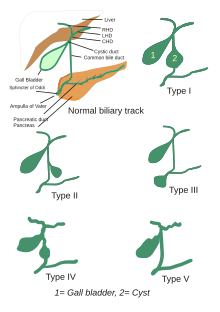Biliary cyst
| Classification according to ICD-10 | |
|---|---|
| Q44.4 | Biliary cyst |
| ICD-10 online (WHO version 2019) | |
Bile duct cysts are congenital malformations of the bile ducts that lead to the expansion of the bile ducts. They are rare in western countries, but are more common in Asia such as Japan and China.
Symptoms
The disease often shows up in the first year of life. It rarely occurs in adulthood and is then usually associated with an increased rate of complications. The classic triad of abdominal pain , jaundice and a hardening in the right upper quadrant of the abdomen is only found in a few patients.
diagnosis
The diagnosis can be made on the basis of anamnesis , palpation, and sonography . The blood test shows an increase in direct or conjugated bilirubin .
Types
The bile duct cysts are divided into five different classes according to Todani 1977.
The classification is based on the site of occurrence of the cyst. It is divided from type I to type IV.
- Type I: Most frequently occurring (80–90%), characterized by saccular or fusiform protrusions of part or all of the common bile duct .
- Type II: Isolated extrahepatic sac of the bile duct.
- Type III or choledochocele: Starting from the duodenal section of the bile duct or the interface with the pancreatic duct .
- Type IVa: Characterized by multiple bulges and / or the intrahepatic and extrahepatic bile duct.
- Type IVb: Multiple bulges that only affect the extrahepatic bile duct.
- Type V: cystic bulging of the intrahepatic bile duct.
therapy
Biliary cysts are treated surgically. The cyst is removed and a Roux-en-Y anastomosis of the bile duct is created. The complications include inflammation of the bile ducts ( cholangitis ) and malignant degeneration (2%), which can form anywhere in the bile ducts. A recently published article also describes the method of removing the cyst laparoscopically and then having the bile ducts run from the liver to the jejunum via a Roux-Y anastomosis . In the case of a saccular-type biliary cyst, the cyst is surgically removed and placed in a T-shaped tube.
Web links
- Resection of a Type I Choledochal Cyst Video. The Toronto Video Atlas of Liver, Pancreas and Transplant Surgery
Individual evidence
- ↑ YB Liu, JW Wang, KR Devkota et al. a .: Congenital choledochal cysts in adults: twenty-five-year experience . In: Chin. Med. J. Band 120 , no. 16 , 2007, p. 1404-1407 , PMID 17825168 .
- ↑ T. Todani, Y. Watanabe, M. Narusue, K. Tabuchi, K. Okajima: Congenital bile duct cysts: Classification, operative procedures, and review of thirty-seven cases including cancer arising from choledochal cyst . In: The American Journal of Surgery . tape 134 , no. 2 , 1977, p. 263-269 , doi : 10.1016 / 0002-9610 (77) 90359-2 , PMID 889044 .
- ↑ M. Diao, L. Li, Q. Li, M. Ye, W. Cheng: Single-incision versus conventional laparoscopic cyst excision and Roux-Y hepaticojejunostomy for children with choledochal cysts: a case-control study. In: World Journal of Surgery . Volume 37, Number 7, July 2013, ISSN 1432-2323 , pp. 1707-1713, doi: 10.1007 / s00268-013-2012-y , PMID 23539195 .
